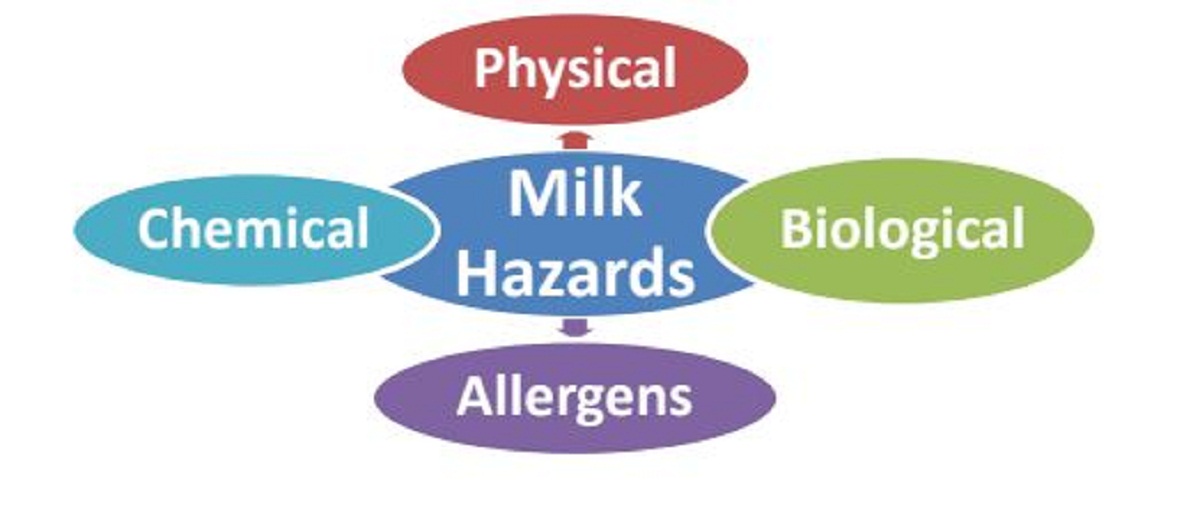Food Safety and Food Safety Hazards in Dairy Industry
Introduction
Dairy industry has the largest share in Food based industry. For young mammals including human infants, milk is the first food ingested and in most cases, it continues to be the sole constituent of the diet for considerable period of time hence there is need to look into the food safety and food safety hazards in dairy industry.
Milk is a complex biological fluid and highly perishable commodity. Milk is a high-risk food product as it is an excellent growth medium for many microorganisms, which have multiple growth range based on surrounding temperature. Many types of bacteria survive and thrive in milk because of its good nutritional quality and it may result in higher bacterial counts and amount of toxins produced by pathogenic organisms, making it unsafe for human consumption.
Factors influencing Food Safety Hazards in Dairy industry
Production of safe and quality milk is a primary requirement for consumers. Milk safety must be controlled at each step from beginning of production to final consumption. Once it is found that any milk is unfit or unsafe for consumption, whether from chemical or physical contamination or microbiological testing, it should be removed from the market.
Removal of chemical hazards or Food Safety Hazards in Dairy industry and impurity is impossible or very difficult through processing and at the ambient temperature
pathogens and spoilage organism can grow faster and affect the consumers, once it is consumed.
Milk Safety Hazard:
There are mainly three types of Hazard in Food, Physical, Chemical and Microbiological Hazard and in similar way Food Safety Hazards in Dairy industry are also divided in the same categories and these may remain in milk through various processes, which carried out for milk processing.
Sources of initial milk hazards may come at primary stage of milk secretion/ milking process from milk giving animal, through interior of udder, udder and teat surfaces. Second source of hazard could be from process of milking, reception, storage etc., through milking equipment, milk transport line and storage tank.
Other source of Food Safety Hazards in Dairy industry could be milking environment, air, water and personal hygiene. In addition to these, chemical hazards might be come through cleaning and sanitising stages. Presence of any of these food hazards shows poor results of milk processing and hygienic practices.

Physical Hazard:
In milk production system, chances of contamination of milk with various types of foreign material or other particle could be hazardous and result as physical hazard to milk consumers.
Common physical Food Safety Hazards in Dairy industry:
- Broken pieces of glass or tiny metals.
- Chipped pieces from equipment
- Metal shavings from cans and foils
- Plastic or chipped pieces of disposables
- Lint and threads
- Hair
- Finger nails
These types of impurities have greater chance for milk, which is neither processed nor passed through screening and filtration process. Severity of these particles noted greater in raw and unprocessed milk.
Chemical Hazard as Food Safety Hazards in Dairy industry:
Usage of chemicals in milk farms and Dairy plants leads to chemical hazards.
Chemical were found in milk samples because of poor milk handling practices and fraudulent practices done at the farm.
Chemicals have been added severely to deteriorate milk quality.
Common added Chemical Food Safety Hazards in Dairy industry (contaminants) include:
- Detergents
- Urea
- Starch
- Sugars
- Vegetable fats
- Neutralizer
- Hydrogen peroxide
Chemical hazards are not limited to added substances but also include certain process-induced contamination, which includes
- Pesticides, Colourants
- Antimicrobial Drugs
- Antibiotic Residue
- Hormones
- Sanitizers and Disinfectants
- Heavy Metals
- Mycotoxins
- Equipment Lubricants
- Food Additives and Preservatives
- Packaging materials-migration of residues from packaging material to milk
Biological Hazards Food Safety Hazards in Dairy industry
Microbiological hazards are a major food safety concern in the Dairy sector because milk is an ideal medium for the growth of bacteria. These can be introduced into the milk from the environment or from the dairy animals themselves.
Milk can contain harmful microorganisms such as Salmonella,Escherichia coli, Listeria monocytogenes, Staphylococcus aureus, Yersinia enterocolitica, Bacillus cereus, Clostridium botulinum, Mycobacterium bovis, Brucella abortus and Brucella
melitensis.
Chances of growth and survival of these pathogens are mostly temperature and time dependent, for which milk been handled as unprocessed during supply chain.
Sources of Bacteria in Raw Milk:
- Bacteria from teats
- Flora of mastitis animals
- Exterior of animal
- Dairy barn environment
- Milk contact surfaces
- Dirty equipment
- Inappropriate milk storage time/temperature
Biological Hazards causes –
a. Food Borne Infections–
This result when a person consumes food containing pathogens; which grow in the human intestine and cause discomfort or disease. Typical symptoms of a ‘food borne Infections’ do not appear immediately.
b. Food Borne Intoxications –
This result when a person consumes food containing toxins in it; that cause discomfort or disease.
Typical symptoms of a ‘food borne Intoxication’ appear quickly. Food Borne toxins are mediated infections, that result when a person consumes food containing toxins produced by the pathogens in it; which grow in the human intestine and produce toxins that
cause discomfort or disease.
To read such an amazing articles please do visit our website dairyheaven.com


